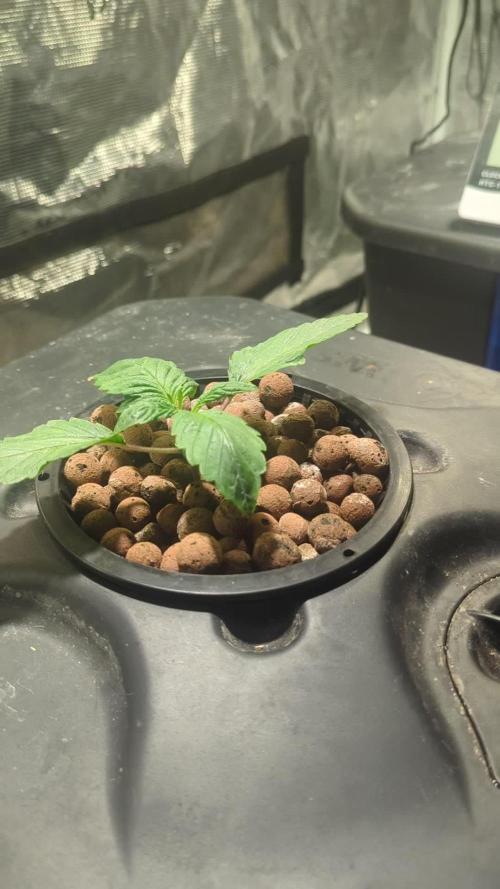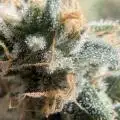The Grow Awards 2026 🏆 

























Processing
Likes
Comments
Share


@JohnnyGrower
Follow
Esta semana los nutrientes siguen de la misma manera, es notorio el exceso de Nitrogeno por ende se disminuira en los próximos riegos, se realizaron podas apicales en los clones que no les hice anteriormente para que alcanzaran más altura. Dentro de esta semana instalare la malla scrog Kanovi para guiar los vigorosos brotes.
Además esta semana ya esta retomando el crecimiento la planta madre variedad Tangie la cual cumplió su ciclo de propagación por esquejes y porfin florecerá.
Leo comentarios, opiniones y recomendaciones
Likes
88
Share


@NAS_Garden
Follow
🌸🌿 Week 3: Blooms Unleashed! 😁
The stretch has gracefully come to an end, and now, the buds are making their grand entrance! 😁 Standing tall, our Lemon Orange proves to be a formidable presence, prompting the need for some strategic topping and ScrOG to keep its height in check.
Growth Management:
Given its impressive stature, a little intervention with topping and ScrOG is in order to ensure the plant stays within bounds. It's all about orchestrating the dance of growth.
Aromas in Bloom:
As the buds unfurl, so do the enchanting aromas. A symphony of citrus notes fills the air, signaling the flourishing flower stage. The pace is exhilarating, promising a delightful harvest in the making.
Nutrient Nurturing:
In the spirit of balance, I've opted for a mindful approach, utilizing only 80% of the recommended nutrients by Terra Aquatica. It's a careful dance to provide just what our Lemon Oranges needs for optimal growth and flavor development.
The stage is set, and our Lemon Orange beauties are gearing up for a floral spectacle. With each passing week, the anticipation for the harvest grows, and the journey unfolds in a crescendo of green and citrusy bliss! 🌼🍊🌿
Processing
Likes
3
Share


@Therbalist
Follow
Back into Veg again, never Lollipoped anything before. Was tough not cropping them buds lol the few I did have to were delicious!
In the big square green pot to the left of the little silver haze X critical XXL is several different cuttings off three different zkittles plants.
One showing bright purple buds the other is less colourful.
The silver haze X critical XXL has had the lowest branch converted to produce male sacs for seeds wasn't very successful so I'm lollypoping to try again.
The other Greenhouse has my favourite large Zkittles which I had a few buds off! Superb taste.
Three chocolate skunk in the same pot two smaller one where fully converted to male. Had all the best cola buds of her also delicious smoke.
Aim is to cross chocolate skunk with zkittles hopefully with more success this time round!
Likes
35
Share


@TheBudWhisperer
Follow
6th week of veg. Is finally in the books and all systems are go for the flower show. As they’re revegged clones, their branching structure is just ridiculous. Sucker branches everywhere pulling nutrient flow away from the winners. Right before we flipped and as per videos - we gutted every single plant and crushed it down to no more than about 7 tops max per plant. The whole goal is only to flower select, top shelf bud with every opportunity (and space) to grow to its fullest potential. So far, Druid nutrients has fit the bill for every one of em and they’re all extremely happy on this system👍.
We also couldn’t resist and snipped another run of clones off each one but the Skywalker. Not sure if the boogie nights or blueberrys will make it but u never really know do you🤷. That said, the diy aerocloner has been a beast for us and minus an aphid issue last round - she puts out a 100% success rate😉.
We’ll use the best of these as complimentary to reg. Run of some spicy bitch we’ve got coming up. Even if the pollen chuck is a failure - we won’t be losing any of the elite white widow or blueberry genetics🤞🤞🤞🤞. Other than that - it’s all wait’n on the buds now👍👌👍. Until next week.
Background
This ones tied to part 2 of the pollen chuck. They were supposed to be a clone run for pollination but the mothers all reveg’d due to a timer incident and high stupidity. These will be the inaugural flowering run of the revamped dutchy system. Growing made easy😉. Shit ton of finagling and setup but once she’s ready - sit back, relax and watch em grow😍😎. Thanks for take’n a look.
Likes
223
Share


@Tropicannibis_Todd
Follow
💩Holy Crap We Are Back At It And Loving It💩
Growmies we are at DAY 35 and she's just killing💀it👌
👉We are in the Preflower stretch 👈 OG 👍 GP 👍 AF was the hold out be she finally went into Preflower 👈
So Shit , I gave them just a tad to much nutes on the last feeding 👈 But I have since fixed it
So I'm starting to pull her over and do some low stress training 🙃 and some defolation 😳
Lights being readjusted and chart updated .........👍rain water to be used entire growth👈
👉I used NutriNPK for nutrients for my grows and welcome anyone to give them a try .👈
👉 www.nutrinpk.com 👈
NutriNPK Cal MAG 14-0-14
NutriNPK Grow 28-14-14
NutriNPK Bloom 8-20-30
NutriNPK Bloom Booster 0-52-34
I GOT MULTIPLE DIARIES ON THE GO 😱 please check them out 😎
👉THANKS FOR TAKING THE TIME TO GO OVER MY DIARIES 👈
Likes
11
Share


@Jeremi420
Follow
Giorno 42. Ciao a tutti. Profumi intenti anche questa settimana. In attesa che gonfino ancora un po'. Credo 2 settimane e saranno pronte per il taglio. Un saluto a tutti ✌️💚.
Likes
Comments
Share


@Lovebud
Follow
Good start so far for the girls .
Proper good
roots for only a few days . Already 2nd set of leafs have come out .
E.C is still 0.6 although I will bump that up later in the week .
Likes
20
Share


@JohnnyBlaz3
Follow
Realized I was a week behind so I updated a few days early but same same lol she is looking and smelling great. when its calm out she definately has a very pleasurable stank to her within a few feet radius. Shes actually starting to get some nice little flowers on her 😋 mayb i'll get like 10-14 dried grams??? guess well see but whatever it is dont really matter, already stoked to try again next year but i'll be doing things a little differently and also i'll add a couple more now that i know autos solve the issues of outdoor growing in a very short summer season. will not be using fabric pots outdoors anymore being the main change.
Likes
13
Share


@TheDrGreenThumb
Follow
I think 💭 that I might just grow this for a third time the yeild was amazing plus almost a half pound in hash. IM in love with SeedsMan early skunk00
Likes
1
Share


@Izzydawizzy
Follow
Plants seem healthy, some lower growth discolored. I read coco coir should be feed more often than not and that one should not let it dry out like soil. I will be watering every other day now until run off. Plants eating way more as run off is not as much as was. Will be raising amount of water in next feed. I topped a majority of the side branching on both these plants, I have also done some super cropping and I continue to do lst. Wonder pie is 10 inches along main stem to tip of the tops. Milky Dreams is 11 inches along main stem and is my biggest plant. Wonder pie seems to produce more bud sites and truly seems like a wild plant.
Likes
10
Share


@WakeAndBake
Follow
finished and everything is in the jars taste is nice more like a tangerine 🍊 orange 🍊 not really happy what shows on the scale but still good
Likes
38
Share


@MadeInGermany
Follow
Info:
Unfortunately, I had to find out that my account is used for fake pages in social media.
I am only active here on growdiaries.
I am not on facebook instagram twitter etc All accounts except this one are fake.
Have fun with the update.
Hey everyone 😀.
A week with a wonderful development is over again 😃.
I decided to stay in the vegi for another 10-14 days and to top it off a few more times.
Then it is put into bloom.
Until then, I wish you all the best 🙏🏻.
You can buy this Strain at :
https://www.zamnesia.com/de/4532-zamnesia-seeds-gorilla-glue-feminisiert.html
Type:
Gorilla Glue
☝️🏼
Genetics:
Chem's Sister x Chocolate Diesel
50% Sativa/50% Indica
👍
Vega lamp:
2 x Todogrow Led
Quantum Board 100 W
💡
Bloom Lamp :
2 x Todogrow Led
Cxb 3590 COB 3500 K 205W
💡💡☝️🏼
Soil :
Canna Coco Professional +
☝️🏼
Fertilizer:
Green House Powder Feeding
☝️🏼🌱
Water:
Osmosis water mixed with normal water (24 hours stale that the chlorine evaporates) to 0.2 EC. Add Cal / Mag to 0.4 Ec Ph with Organic Ph - to 5.5 - 5.8 .
Likes
18
Share


@ADHDselfmedication
Follow
3 seeds from barneys farm : zkittlez Og auto.
Diary :
Day 1:
I dug a pit and cleaned my dirt with metal grid and a wheelbarrow & Installed the greenhouse.
Day 2 : I rotated my dirt and added universal soil. 4 x 70l to area of 6m2 . I also planted seeds in universal soil without sprouting first.
Day 3 :
I gave water and checked for sprouts. Bought moist meter and dripping hose.
Installed those and making the greenhouse more moisty now.
Putted seeds in small sprout basket for now.
Feeling : Verry happy for my first time. Lots to learn.. . Excited






























